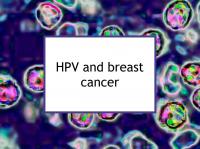Human papillomavirus (HPV), which causes most cases of cervical cancer, has been found in breast cancer tissue. It is generally accepted that HPV has a role in some cases of head and neck cancer, as well as anogenital tumors. HPV has also been found in many other cancer tissues, possibly indicating only that the patients are infected with HPV.
Importantly, no epidemiological studies have found that women with cervical cancer are more likely to get breast cancer. Are HPVs mere passengers in breast cancer cells or do they have a causal role?
The case against an HPV—breast cancer connection
While HPV has been found in breast cancer tissues of women in many countries, including Australia, Brazil, China, Egypt, India, Iran, Japan, Jordan, Korea, Mexico, Morocco, Qatar, Singapore, Syria, and Taiwan, results have been inconsistent and the HPV testing methodology has been questioned in some cases. One U.S. study found HPV in only three of 67 breast cancer cases and a French study found no HPV in 50 breast cancer tissue samples, suggesting that HPV does not play an important role in most breast cancer.
On the other hand, a Danish study found a slightly elevated risk of breast cancer for women who underwent cervical conization (excision of a cone-shaped sample of tissue from the mucous membrane of the cervix) and presumably had HPV infections. Other studies have also reported a higher prevalence of HPV infection among breast cancer cases than women without breast cancer.
Possible mechanisms of action
If there is an HPV/breast cancer connection, it means that infection with high-risk HPV has the potential to trigger malignant transformation of infected cells. Evidence for such a relationship and possible mechanisms of action are given below:
- Women with HPV-positive breast cancer have been reported to be significantly younger than women with HPV-negative breast cancer, suggesting a different etiology for the younger women involving a causal role for HPV
- Certain types of breast cancer (such as triple negative, but not HER2+) often have distinct features similar to HPV-related cancers of the oropharynx, penis, and vulva
- The ErbB-2 receptor, which is overexpressed in approximately 30% of human breast cancers, was shown to cooperate with HPV type 16 oncoproteins in stimulating colony formation and cell migration of breast cancer cells in one study
- Another study found that HPV type 16 oncoproteins were capable of converting non-invasive breast cancer cells to invasive breast cancer cells
- The tumor suppressor p53 gene often is mutated in cancer, but not in HPV-associated tumors. One study reported synergistic interactions between estrogen and p53 insufficiency in influencing the nature of HPV-associated carcinogenesis in hormone-responsive tissues, such as the breast and the reproductive tract.
Gardasil protects against infection by HPV found in breast cancer
Gardasil, a vaccine which protects against infection by HPV types 16 and 18, was approved by the U.S. Food and Drug Administration (FDA) in 2006. HPV types 16 and 18 are believed to cause approximately 70 percent of all cases of cervical cancer (at least 17 other types of HPV are responsible for the remaining cases). Gardasil also protects against HPV types 6 and 11, which cause genital warts but do not cause cervical cancer.
While HPV appears to be transmissible through exchange of bodily fluids, it is also transmissible by means of skin to skin contact. In fact, several observers have suggested that it can be transmitted directly to the breasts through the skin or nipples during sexual contact. If HPV has a role in causing breast cancer, vaccination against HPV might prevent some breast cancers. This possibility provides another reason to vaccinate our daughters. It remains to be seen whether young women who are vaccinated with Gardasil will have lower lifetime rates of breast cancer.
Bottom line
Based on the available evidence, there appears to be some potential for common strains of HPV to contribute to breast cancer development and recurrence in a limited number of cases. The level of risk associated with HPV infection has not been determined. It appears to be higher for young women, however it is not clear why this risk should dissipate over time if HPV infection persists. Given the well-established association of HPV with cervical and some forms of head and neck and anogenital cancer, it is in any case important to have our teenagers vaccinated against HPV and to take steps to avoid HPV infection.
Below are links to 20 recent studies concerning this topic. For a more complete list of studies, please click on HPV.
